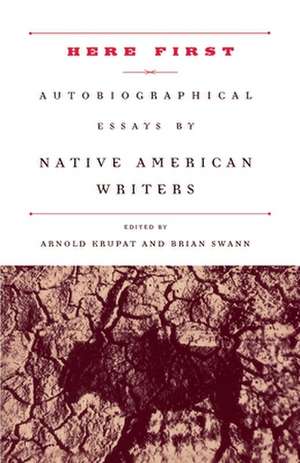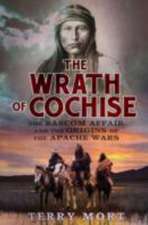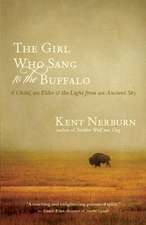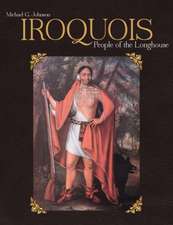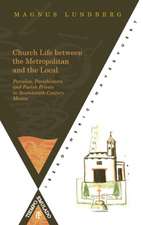Here First: Autobiographical Essays by Native American Writers: Modern Library (Paperback)
Editat de Arnold Krupat, Brian Swannen Limba Engleză Paperback – 31 mai 2000
Din seria Modern Library (Paperback)
-
 Preț: 129.93 lei
Preț: 129.93 lei -
 Preț: 90.25 lei
Preț: 90.25 lei -
 Preț: 124.55 lei
Preț: 124.55 lei -
 Preț: 120.25 lei
Preț: 120.25 lei -
 Preț: 112.74 lei
Preț: 112.74 lei -
 Preț: 169.74 lei
Preț: 169.74 lei -
 Preț: 108.33 lei
Preț: 108.33 lei -
 Preț: 100.57 lei
Preț: 100.57 lei -
 Preț: 107.35 lei
Preț: 107.35 lei -
 Preț: 155.91 lei
Preț: 155.91 lei -
 Preț: 142.38 lei
Preț: 142.38 lei -
 Preț: 133.47 lei
Preț: 133.47 lei -
 Preț: 126.88 lei
Preț: 126.88 lei -
 Preț: 134.93 lei
Preț: 134.93 lei -
 Preț: 120.07 lei
Preț: 120.07 lei -
 Preț: 119.74 lei
Preț: 119.74 lei -
 Preț: 122.76 lei
Preț: 122.76 lei -
 Preț: 119.36 lei
Preț: 119.36 lei -
 Preț: 112.33 lei
Preț: 112.33 lei -
 Preț: 79.39 lei
Preț: 79.39 lei - 18%
 Preț: 97.51 lei
Preț: 97.51 lei -
 Preț: 137.09 lei
Preț: 137.09 lei -
 Preț: 103.26 lei
Preț: 103.26 lei
Preț: 142.79 lei
Nou
Puncte Express: 214
Preț estimativ în valută:
27.32€ • 28.60$ • 22.61£
27.32€ • 28.60$ • 22.61£
Carte disponibilă
Livrare economică 15-29 martie
Preluare comenzi: 021 569.72.76
Specificații
ISBN-13: 9780375751387
ISBN-10: 0375751386
Pagini: 448
Dimensiuni: 141 x 222 x 27 mm
Greutate: 0.58 kg
Ediția:2000
Editura: Modern Library
Seria Modern Library (Paperback)
ISBN-10: 0375751386
Pagini: 448
Dimensiuni: 141 x 222 x 27 mm
Greutate: 0.58 kg
Ediția:2000
Editura: Modern Library
Seria Modern Library (Paperback)
Notă biografică
Arnold Krupat is the author of several books, including The Turn to the Native: Studies in Criticism & Culture and the novel Woodsmen, or Thoreau and the Indians. He teaches at Sarah Lawrence College.
Brian Swann has published a number of collections of poetry and fiction, including Wearing the Morning Star: Native American Song-Poems and Coming to Light: Contemporary Translations of the Native Literatures of North America. He teaches at the Cooper Union in New York City.
Brian Swann has published a number of collections of poetry and fiction, including Wearing the Morning Star: Native American Song-Poems and Coming to Light: Contemporary Translations of the Native Literatures of North America. He teaches at the Cooper Union in New York City.
Extras
INTRODUCTION
This book is a follow-up volume to I Tell You Now.- Autobiographical Essays by Native American Writers, published by the University of Nebraska Press in 1987. We began putting the collection together more than ten years ago, in 1985, BCQ--Before the Columbian Quincentennial--and also, therefore, before Dances With Wolves, Blackrobe, various "Geronimos," and the Tony Hillerman explosion. The appetite of the American public for things Indian has expanded, as happens from time to time. This has resulted, on the one hand, in an increase in the production of what might be called "cultural fast food" (and New Age "plastic shamanism"-for example, the egregious decision by Marvel Comics to publish an issue involving Hopi kachinas)-but also, on the other, has opened a very real, if still small, space for Native American writers, painters, and scholars to present some spiritually and intellectually nourishing fare.
Our concern in Here First, as it was in the earlier volume, is with Native American writers and with aspects of autobiography.' For a brief history of Native American autobiography, the reader might wish to turn to the Introduction to I Tell You Now, and there are also a number of fine studies of the genre currently available.' In the preparation of this volume we set out in much the same way we did then: we attempted to contact as many contemporary Native American writers as we knew of for contributions, and we asked them to speak of their lives and their relation to their art. inevitably, there are some people we missed, and we can only apologize for that; any Native writer who is not represented in this volume was in no way intentionally excluded. Some who do not appear told us they were simply too busy to produce essays in time for our deadline; others felt that they had spoken about themselves sufficiently-in essays, interviews, and, indeed, earlier autobiographical texts-not to wish to undertake the task again. In one instance, however, a Native writer chose to exclude himself because many of the Native writers we had published in I Tell You Now were unenrolled, or, as he wrote, "self-nominated Indians," and he did not wish to appear in any follow-up volume that might include other, to him, at least, questionable Natives.
This matter of identity-Who is an Indian?-has become a very hotly debated issue of late, and it would be irresponsible of us not to say just a brief word about it. There are, to speak broadly, three positions on this matter; they can be designated the nationalist, the indigenist, and the cosmopolitan positions. Nationalists generally define Indian identity as a matter of tribal enrollment regardless of what a particular tribal nation's criteria for enrollment may be-and "among federally recognized tribes in the United States, blood quantum ... is the most common criterion of membership." (Strong and Van Winkle, 555)' Indigenists find this position unacceptably "Eurocentric," and, instead, look to an ecologically based philosophy or system of indigenous values that define a global "Fourth World." In the United States, adherence to these values should be constitutive of an indigenous identity regardless of "blood," although indigenists seem somewhat ambivalent about whether just anyone can be Indian.' The cosmopolitan position, represented foremost by the Chippewa (Anishinaabe) writer Gerald Vizenor, seems fairly clear on this matter, however. In several of the essays in his Manifest Manners: Postindian Warriors of Survivance (1994), and in his novel, The Heirs of Columbus (1992), Vizenor is critical (as are the indigenists) of "the racist arithmetic measures of tribal blood," and he has Stone Columbus, one of the "heirs" of Columbus, affirm that he would accept as "tribal" anyone committed to the values of healing rather than stealing tribal cultures, "no blood attached or scratched." (Heirs, 162)
For all of this, as non-Native scholars, we find the position articulated by Brian Swann some years back in his Introduction to Duane Niatum's Harper's Anthology of 20th Century Native American Poetry the most useful to adopt in practice: "Native Americans are Native Americans if they say they are, if other Native Americans say they are and accept them, and (possibly) if the values that are held close and acted upon are values upheld by the various native peoples who live in the Americas." (Niatum, xx). So far as we know, all those represented in this book have legitimate, if on occasion complex claims to Native American identity.
Native American writers, as we knew from our experience editing I Tell You Now--in this they are rather different from most EuroAmerican writers-are sometimes reluctant to talk about themselves, to dwell on "merely personal" matters. Although all of those who appear here have, in the end, committed themselves to writing autobiographically, a substantial number of them told us, often more than once, how very difficult they found the process. Indeed, one poet who had been unwilling to contribute to I Tell You Now, with the passage of time, decided she might, now, offer an essay; as formerly to do so seemed inappropriate, presently she felt it would be a good thing to try.
The regret we feel about those who are not represented in this volume should not obscure our great satisfaction at how many fine writers are represented, twenty-six in all. The reader will decide, of course, what to make of this volume as a whole, but we want to offer here some observations of our own. Structurally, as will be immediately apparent, we have chosen to present the authors in alphabetical order. The arrangement of I Tell You Now was chronological, the elder contributors appearing first, so that anyone reading the volume from beginning to end would begin with Mary Tallmountain, born in 1918, going on then to Ralph Salisbury and Maurice Kenny, born in the twenties, to Elizabeth Cook-Lynn, born 1930, and concluding with our youngest essayist, Joy Harjo, born 195 1. This arrangement, we thought, would enable the reader to have a sense of continuity and change in the life experience of Native writers. Although the present volume is pleased to include some older Native American writers, the bulk of what appears is from writers born in the forties and after, a fact that seemed to dilute the potential usefulness of a chronological presentation: thus the decision to organize the book alphabetically.
Reading and rereading these essays, what has emerged for us most powerfully is, on the one hand, how many different ways there are today to be Indian, and, on the other-no surprise, given that our contributors are creative writers-how many different ways there are to write about being Indian. Thus there are Native writers whose first language was not English and whose first memories are of kin and clan relations of a quite traditional sort. Others are urban or rural mixed-bloods whose relation to their Native heritage was sometimes belated, often hard-won, occasionally conflicted. While no one of our writers comes from what is in Western terms an affluent background, any material poverty he or she may have experienced is not easily reduced to sociological cliché. To be sure, some are conscious of being poor but loved, and some are conscious of having been poor and abused; but others, the traditionally raised people most of all, had no notion whatever that they might be considered "poor" until their encounter with the dominant culture so classified them. Educational experiences also differ: no single generalization about Indians in American schools will suffice to explain what our contributors gained or lost there except perhaps that all were moved by some of the European and American writers they discovered so as eventually to feel their own way to authorship. In much the same way, these essays warn us against generalizing about contemporary Native Americans and religious experience: all of the writers represented have a strong feeling for the spiritual and sacred dimensions of their Native heritage. Yet Western religion, Catholicism in particular, has also played an important role in the formation of some. Meanwhile, as will be apparent, others mention religion little or not at all.
So far as these writers' approaches to their essays are concerned, it is once more variety rather than sameness or consistency that is to be noted. We have a self-interview (Geiogamah), an account of a Catholic education (Hill), a meditation on traditional prayerfulness (Jim), and many pieces focusing on the importance of language (Bell, Owens, Zepeda, et al.). Clifford Trafzer, professionally a historian, offers a quite historical account of his life; urban mixed-bloods like Hilden and Penn, along with Louis Owens, whose mixed-blood background was thoroughly rural, choose not to develop issues of particular tribal affiliation, while Tapahonso and Walters respectively (yet in quite different ways) focus on the specifics of being Navajo and Pawnee. The late Carroll Arnett (to whom, along with Vickie Sears, this volume is dedicated) learned from Ezra Pound, from the Marine Corps, and from a number of inspiring college teachers-yet it was in a dream that he got his name from his Cherokee grandmother.
The testimony of this book, as we see it, is to the extraordinary flowering of some wonderful writing by Native American people. We offer these autobiographical reflections most of all for their power as literature. We hope as well that for any who have already encountered these writers' work, these essays will add to the reader's comprehension. Finally, for those who do not as yet know these writers' work, we hope the essays presented here will whet their appetite for more.
In this regard, let us note that we have not attempted to provide a comprehensive listing of the small presses that have published some of our contributors' work as we did in I Tell You Now. The reader who has trouble finding some of our authors' work will do best to consult The International Directory of Little Magazines and Small Presses, published annually by Dustbooks, P.O. Box 100, Paradise, CA 95969.
It remains only for us to thank some of the people who have helped us in compiling this volume, in particular, Joseph Bruchac, Alfred Bush, Duane Champagne, and the late Michael Dorris.
This book is a follow-up volume to I Tell You Now.- Autobiographical Essays by Native American Writers, published by the University of Nebraska Press in 1987. We began putting the collection together more than ten years ago, in 1985, BCQ--Before the Columbian Quincentennial--and also, therefore, before Dances With Wolves, Blackrobe, various "Geronimos," and the Tony Hillerman explosion. The appetite of the American public for things Indian has expanded, as happens from time to time. This has resulted, on the one hand, in an increase in the production of what might be called "cultural fast food" (and New Age "plastic shamanism"-for example, the egregious decision by Marvel Comics to publish an issue involving Hopi kachinas)-but also, on the other, has opened a very real, if still small, space for Native American writers, painters, and scholars to present some spiritually and intellectually nourishing fare.
Our concern in Here First, as it was in the earlier volume, is with Native American writers and with aspects of autobiography.' For a brief history of Native American autobiography, the reader might wish to turn to the Introduction to I Tell You Now, and there are also a number of fine studies of the genre currently available.' In the preparation of this volume we set out in much the same way we did then: we attempted to contact as many contemporary Native American writers as we knew of for contributions, and we asked them to speak of their lives and their relation to their art. inevitably, there are some people we missed, and we can only apologize for that; any Native writer who is not represented in this volume was in no way intentionally excluded. Some who do not appear told us they were simply too busy to produce essays in time for our deadline; others felt that they had spoken about themselves sufficiently-in essays, interviews, and, indeed, earlier autobiographical texts-not to wish to undertake the task again. In one instance, however, a Native writer chose to exclude himself because many of the Native writers we had published in I Tell You Now were unenrolled, or, as he wrote, "self-nominated Indians," and he did not wish to appear in any follow-up volume that might include other, to him, at least, questionable Natives.
This matter of identity-Who is an Indian?-has become a very hotly debated issue of late, and it would be irresponsible of us not to say just a brief word about it. There are, to speak broadly, three positions on this matter; they can be designated the nationalist, the indigenist, and the cosmopolitan positions. Nationalists generally define Indian identity as a matter of tribal enrollment regardless of what a particular tribal nation's criteria for enrollment may be-and "among federally recognized tribes in the United States, blood quantum ... is the most common criterion of membership." (Strong and Van Winkle, 555)' Indigenists find this position unacceptably "Eurocentric," and, instead, look to an ecologically based philosophy or system of indigenous values that define a global "Fourth World." In the United States, adherence to these values should be constitutive of an indigenous identity regardless of "blood," although indigenists seem somewhat ambivalent about whether just anyone can be Indian.' The cosmopolitan position, represented foremost by the Chippewa (Anishinaabe) writer Gerald Vizenor, seems fairly clear on this matter, however. In several of the essays in his Manifest Manners: Postindian Warriors of Survivance (1994), and in his novel, The Heirs of Columbus (1992), Vizenor is critical (as are the indigenists) of "the racist arithmetic measures of tribal blood," and he has Stone Columbus, one of the "heirs" of Columbus, affirm that he would accept as "tribal" anyone committed to the values of healing rather than stealing tribal cultures, "no blood attached or scratched." (Heirs, 162)
For all of this, as non-Native scholars, we find the position articulated by Brian Swann some years back in his Introduction to Duane Niatum's Harper's Anthology of 20th Century Native American Poetry the most useful to adopt in practice: "Native Americans are Native Americans if they say they are, if other Native Americans say they are and accept them, and (possibly) if the values that are held close and acted upon are values upheld by the various native peoples who live in the Americas." (Niatum, xx). So far as we know, all those represented in this book have legitimate, if on occasion complex claims to Native American identity.
Native American writers, as we knew from our experience editing I Tell You Now--in this they are rather different from most EuroAmerican writers-are sometimes reluctant to talk about themselves, to dwell on "merely personal" matters. Although all of those who appear here have, in the end, committed themselves to writing autobiographically, a substantial number of them told us, often more than once, how very difficult they found the process. Indeed, one poet who had been unwilling to contribute to I Tell You Now, with the passage of time, decided she might, now, offer an essay; as formerly to do so seemed inappropriate, presently she felt it would be a good thing to try.
The regret we feel about those who are not represented in this volume should not obscure our great satisfaction at how many fine writers are represented, twenty-six in all. The reader will decide, of course, what to make of this volume as a whole, but we want to offer here some observations of our own. Structurally, as will be immediately apparent, we have chosen to present the authors in alphabetical order. The arrangement of I Tell You Now was chronological, the elder contributors appearing first, so that anyone reading the volume from beginning to end would begin with Mary Tallmountain, born in 1918, going on then to Ralph Salisbury and Maurice Kenny, born in the twenties, to Elizabeth Cook-Lynn, born 1930, and concluding with our youngest essayist, Joy Harjo, born 195 1. This arrangement, we thought, would enable the reader to have a sense of continuity and change in the life experience of Native writers. Although the present volume is pleased to include some older Native American writers, the bulk of what appears is from writers born in the forties and after, a fact that seemed to dilute the potential usefulness of a chronological presentation: thus the decision to organize the book alphabetically.
Reading and rereading these essays, what has emerged for us most powerfully is, on the one hand, how many different ways there are today to be Indian, and, on the other-no surprise, given that our contributors are creative writers-how many different ways there are to write about being Indian. Thus there are Native writers whose first language was not English and whose first memories are of kin and clan relations of a quite traditional sort. Others are urban or rural mixed-bloods whose relation to their Native heritage was sometimes belated, often hard-won, occasionally conflicted. While no one of our writers comes from what is in Western terms an affluent background, any material poverty he or she may have experienced is not easily reduced to sociological cliché. To be sure, some are conscious of being poor but loved, and some are conscious of having been poor and abused; but others, the traditionally raised people most of all, had no notion whatever that they might be considered "poor" until their encounter with the dominant culture so classified them. Educational experiences also differ: no single generalization about Indians in American schools will suffice to explain what our contributors gained or lost there except perhaps that all were moved by some of the European and American writers they discovered so as eventually to feel their own way to authorship. In much the same way, these essays warn us against generalizing about contemporary Native Americans and religious experience: all of the writers represented have a strong feeling for the spiritual and sacred dimensions of their Native heritage. Yet Western religion, Catholicism in particular, has also played an important role in the formation of some. Meanwhile, as will be apparent, others mention religion little or not at all.
So far as these writers' approaches to their essays are concerned, it is once more variety rather than sameness or consistency that is to be noted. We have a self-interview (Geiogamah), an account of a Catholic education (Hill), a meditation on traditional prayerfulness (Jim), and many pieces focusing on the importance of language (Bell, Owens, Zepeda, et al.). Clifford Trafzer, professionally a historian, offers a quite historical account of his life; urban mixed-bloods like Hilden and Penn, along with Louis Owens, whose mixed-blood background was thoroughly rural, choose not to develop issues of particular tribal affiliation, while Tapahonso and Walters respectively (yet in quite different ways) focus on the specifics of being Navajo and Pawnee. The late Carroll Arnett (to whom, along with Vickie Sears, this volume is dedicated) learned from Ezra Pound, from the Marine Corps, and from a number of inspiring college teachers-yet it was in a dream that he got his name from his Cherokee grandmother.
The testimony of this book, as we see it, is to the extraordinary flowering of some wonderful writing by Native American people. We offer these autobiographical reflections most of all for their power as literature. We hope as well that for any who have already encountered these writers' work, these essays will add to the reader's comprehension. Finally, for those who do not as yet know these writers' work, we hope the essays presented here will whet their appetite for more.
In this regard, let us note that we have not attempted to provide a comprehensive listing of the small presses that have published some of our contributors' work as we did in I Tell You Now. The reader who has trouble finding some of our authors' work will do best to consult The International Directory of Little Magazines and Small Presses, published annually by Dustbooks, P.O. Box 100, Paradise, CA 95969.
It remains only for us to thank some of the people who have helped us in compiling this volume, in particular, Joseph Bruchac, Alfred Bush, Duane Champagne, and the late Michael Dorris.
Descriere
Twenty-seven Native American writers describe their lives and art in a compelling collection of personal and family histories illuminated by verse and song, story and narrative, all fed by the strong oral tradition of the indigenous peoples of this country. EVERYTHING MATTERS reveals a broad and complex Native American experience.
